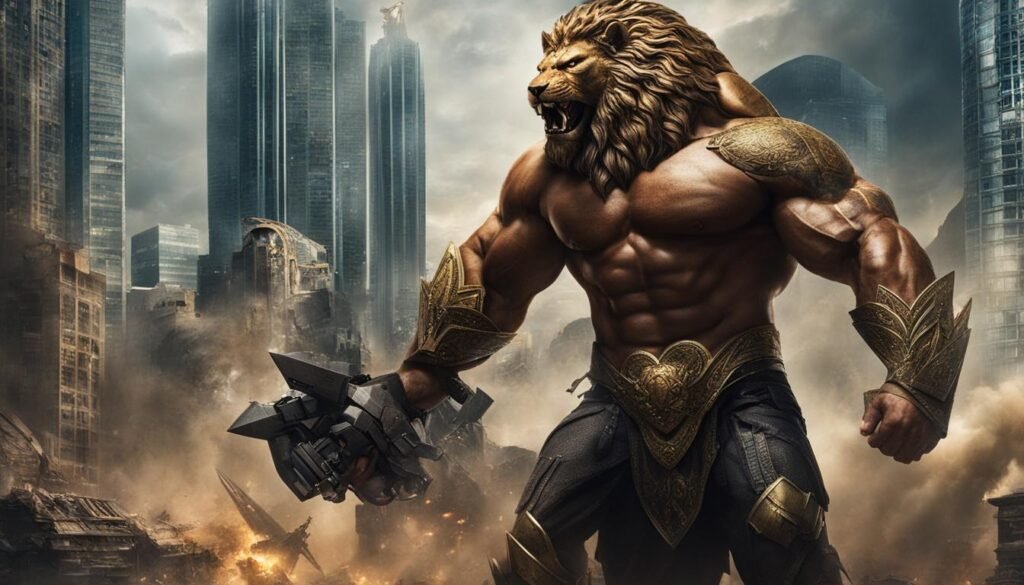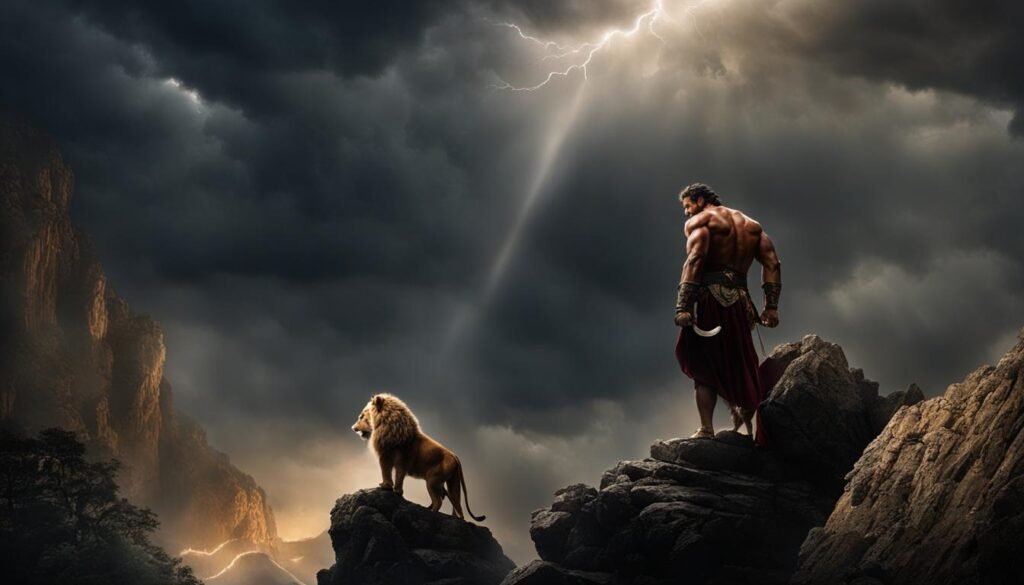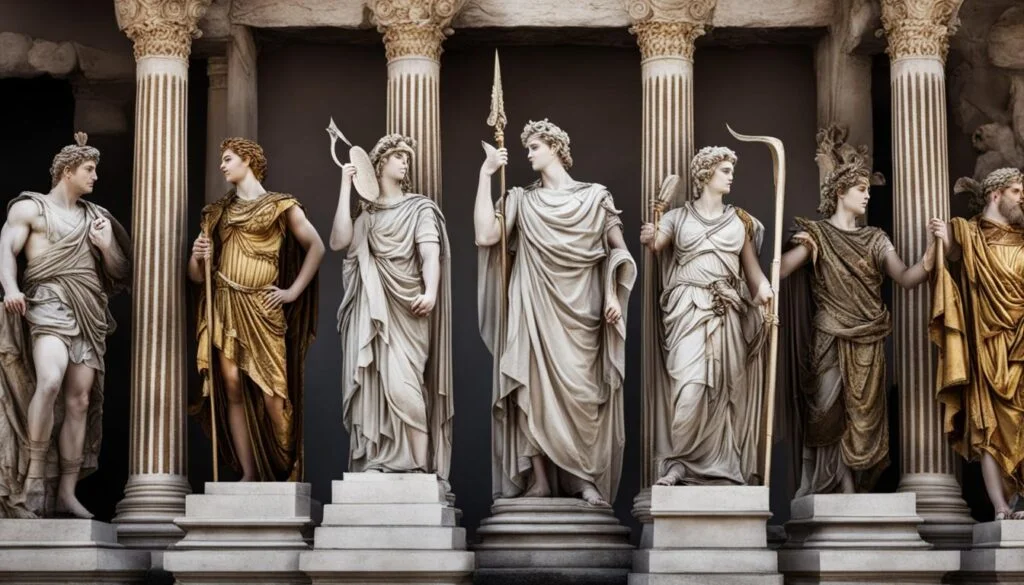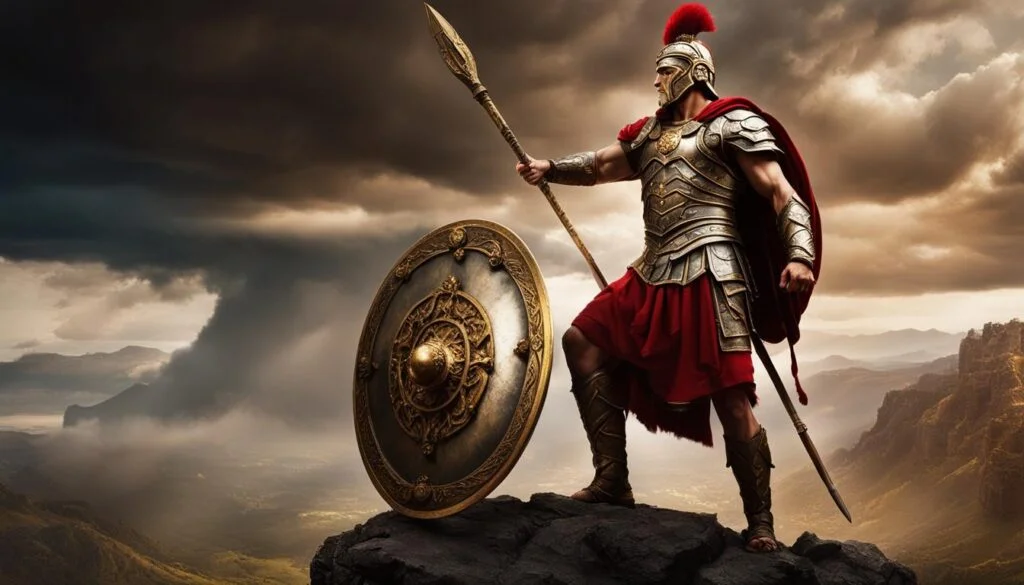In Roman mythology, Hercules, a deified hero, held a prominent place as a symbol of strength, bravery, and victory. His achievements and tasks in Roman mythology were revered, and he became a legendary figure with captivating stories and exploits.
Hercules was worshipped as Victor and Invictus, and he had numerous temples dedicated to him, including the Ara Maxima at the Forum Boarium. Initially, he was revered as a guardian of property, entrances, travelers, and traders. Merchants, travelers, young Roman knights, and chiefs seeking victory found solace in his patronage.
The Feast of Hercules the Great Protector, celebrated on June 4th in Rome, further showcased his significance in Roman society and culture. High-ranking Roman leaders like Pompey the Great, Mark Antony, Emperor Trajan, and Emperor Commodus recognized him as a patron of victorious war.
Key Takeaways:
- Hercules was worshipped as a guardian of property, entrances, travelers, and traders in Roman mythology.
- He held a significant place in Roman society and culture, with temples and feasts dedicated to him.
- Hercules was recognized as a patron of victorious war by influential Roman leaders.
- His stories and exploits showcased his strength, bravery, and victory.
- Hercules’ influence extended beyond the military sphere and impacted various aspects of daily life.
Hercules as a Hero and Symbol of Strength
Hercules, the legendary hero of Roman mythology, is celebrated as a symbol of strength and bravery. His remarkable feats have solidified his place in history and his name has become synonymous with power and resilience.
One of Hercules’ most famous accomplishments is the completion of the Twelve Labors, undertaken as a penance for the tragic murder of his wife and children. These labors showcased his exceptional physical prowess and unwavering determination. From slaying the Nemean Lion to capturing the Cretan Bull, Hercules demonstrated his unmatched strength and indomitable spirit.
In addition to his legendary feats, Hercules also had significant relationships with women. His first wife, Megara, tragically met her demise at the hands of Hercules in a fit of madness induced by the goddess Hera. He later formed a bond with Hippolyta, the fearless queen of the Amazons. These relationships highlight the multidimensional nature of Hercules as a hero, capable of love and compassion in addition to his incredible physical abilities.
Throughout Roman mythology, Hercules remains an enduring symbol of strength and valor. His stories continue to inspire generations, reminding us of the extraordinary power that lies within each of us.
The Twelve Labors of Hercules:
- Slaying the Nemean Lion
- Defeating the Lernaean Hydra
- Capturing the Golden Hind of Artemis
- Capturing the Erymanthian Boar
- Cleaning the Augean Stables
- Defeating the Stymphalian Birds
- Capturing the Cretan Bull
- Obtaining the Mares of Diomedes
- Obtaining the girdle of Hippolyta, the Queen of the Amazons
- Obtaining the cattle of the monstrous Geryon
- Stealing the apples of the Hesperides
- Capturing and bringing back Cerberus, the three-headed dog guarding the entrance to the Underworld
Hercules in Roman Art and Literature

Hercules, the legendary hero of Roman mythology, has left an indelible mark in the realms of art and literature. His iconic portrayal in ancient artworks showcases his strength and valor, captivating audiences throughout the centuries.
Depiction in Ancient Art
A plethora of sculptures and reliefs immortalize Hercules’ heroic endeavors, adorning temples, public spaces, and private residences. These artworks emphasize his muscular physique and depict him engaged in epic battles with mythical creatures. Hercules’ representation in ancient art serves as a testament to his status as a symbol of strength and bravery.
Works in Written Literature
Hercules’ adventures and feats have been extensively chronicled by renowned authors in Roman literature. Writers like Ovid and Virgil have delved into the intricacies of his character, weaving captivating tales that exemplify his stature as a complex and multidimensional hero. Through their written works, Hercules’ story captivates readers, providing a deeper understanding of his place in Roman mythology.
From sculptures to paintings and written narratives, the depiction of Hercules in Roman art and literature serves as a testament to his enduring legacy. His story continues to inspire and fascinate, captivating audiences across generations with his strength, resilience, and indomitable spirit.
Hercules in Roman Society and Culture

In Roman society and culture, Hercules held a significant place as both a deity and a symbol of strength and victory. As a deity, he was worshipped and revered by the Roman people, particularly in the military sphere where he was considered the patron of victorious soldiers. His influence extended beyond the military, shaping various aspects of daily life.
The story of Hercules inspired values such as determination, resilience, and the indomitable human spirit. His legendary feats and character resonated with the Roman people, who adorned their homes, public spaces, and even clothing with representations of Hercules. His association with fertility and childbirth also made him a patron figure in those realms.
Hercules in Roman Society and Culture: Key Points
- Hercules was worshipped as a deity and symbol of strength and victory in Roman society.
- He was considered the patron of victorious soldiers in the Roman military.
- Hercules’ story inspired values such as determination, resilience, and the indomitable human spirit.
- Representations of Hercules adorned Roman homes, public spaces, and clothing.
- He was associated with fertility and childbirth, making him a patron figure in those realms.
The widespread influence of Hercules in Roman society and culture speaks to his enduring legacy. His story continues to fascinate and inspire audiences across generations, leaving an indelible mark on both Roman and Greek cultures. From his status as a deity and patron of victorious soldiers to his impact on daily life, Hercules exemplifies the timeless appeal of strength, bravery, and the triumph of the human spirit.
Hercules in Popular Culture and Contemporary References

In addition to his prominent place in Roman mythology, Hercules continues to captivate audiences worldwide in popular culture. His legendary feats and charismatic character have been depicted in numerous films, television shows, and adaptations, ensuring that his story remains alive and influential in modern times.
One of the most notable adaptations of Hercules is the widely acclaimed animated film released by Disney in 1997. This imaginative retelling of the hero’s journey became an instant classic, captivating both children and adults with its catchy songs, vibrant animation, and a charming portrayal of Hercules’ adventures. The film’s enduring popularity has cemented Hercules as a beloved figure in contemporary animation.
Moreover, Hercules has made a significant impact on the television landscape. Several TV series have embraced his character, offering their unique interpretations of the legendary hero. From the iconic 1990s television series “Hercules: The Legendary Journeys” to the more recent modern-day adaptation “Hercules: The Thracian Wars,” his story has found a home on the small screen, captivating audiences with thrilling adventures and compelling character development.
Hercules’ influence extends beyond the realm of entertainment. His symbolic presence can be found in various aspects of modern culture, including literature, art, and even sports. His name has been adopted by numerous athletic teams and fitness programs, evoking the hero’s strength and determination. Through these contemporary references, Hercules remains an iconic figure who inspires individuals to strive for greatness and overcome challenges.
Key Points:
- Hercules is a popular and influential figure in modern popular culture.
- The Disney animated film released in 1997 contributed to the enduring popularity of Hercules.
- Television adaptations, such as “Hercules: The Legendary Journeys,” have brought new life to the hero’s story.
- Hercules’ influence extends to other areas of contemporary culture, including literature, art, and sports.
Conclusion
Hercules, the legendary hero of Roman mythology, remains a fascinating and influential figure in both Roman and Greek cultures. His story, filled with heroic deeds and complex relationships with women, showcases his strength, bravery, and the indomitable human spirit.
Throughout Roman society and culture, Hercules held a significant place. As a symbol of strength and victory, he was revered as a deity and worshiped by the Roman military as the patron of victorious soldiers. His enduring influence extended beyond the military sphere, permeating various aspects of daily life and inspiring values like determination and resilience.
In popular culture, Hercules continues to captivate audiences through films, television shows, and modern adaptations. His legendary feats and character have left an indelible mark on contemporary references, cementing his status as an iconic figure in our collective imagination.
In conclusion, Hercules’ timeless appeal lies in his multidimensional nature and the enduring impact he has had on Roman and Greek cultures. As a symbol of strength, bravery, and the indomitable human spirit, Hercules’ story will continue to inspire and fascinate generations to come.
FAQ
What did Hercules do in Roman mythology?
Hercules was a deified hero who was worshipped as Victor and Invictus. He had several temples dedicated to him and was initially worshipped as a guardian of property, entrances, travelers, and traders. He was especially popular among merchants, travelers, young Roman knights, and chiefs seeking victory.
What were Hercules’ most famous feats?
Hercules’ most famous feats are the Twelve Labors, which he completed to atone for killing his wife and children. These labors showcased his exceptional physical prowess and determination.
What relationships did Hercules have with women?
Hercules had significant relationships with women such as Megara, his first wife, and Hippolyta, the Amazon queen. These relationships highlight the multidimensional nature of Hercules as a hero.
How was Hercules depicted in Roman art and literature?
Hercules was a prominent figure in Roman art and literature. Many artworks depicted him battling mythical creatures or completing his twelve labors. Written works by renowned authors like Ovid and Virgil explored Hercules’ adventures, highlighting his place in Roman mythology and his role as a complex and multidimensional character.
How did Hercules influence Roman society and culture?
Hercules was revered as a deity and a symbol of strength and victory in Roman society. The Roman military especially worshipped him as the patron of victorious soldiers. His story inspired values like determination and resilience, and he was associated with fertility and childbirth. Representations of Hercules adorned Roman homes, public spaces, and even clothing, showcasing his widespread influence.
How is Hercules portrayed in popular culture and contemporary references?
Hercules continues to captivate audiences in popular culture through films, television shows, and adaptations. His legendary feats and character are depicted in various forms of media, bringing his story to new generations. From classic films like “Hercules” (1958) to modern adaptations, Hercules has left an indelible mark on contemporary references. He remains an iconic figure in our collective imagination.




